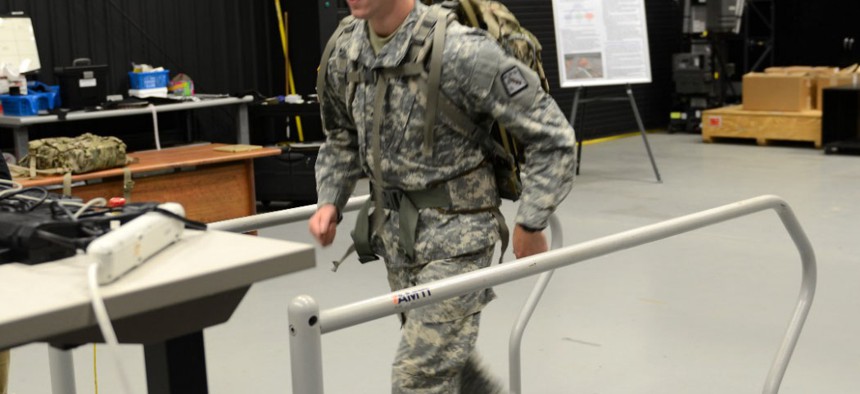Backpack generates power through soldiers' motion
The Energy Harvester Assault Pack could eliminate the need to carry batteries by harnessing the power produced through natural movement.
One of the biggest concerns for the military focuses around size, weight and power constraints. It applies in the air, where aerial assets must be able to take off and fly properly without being weighed down by too many payloads. It’s also true on the ground for soldiers whose packs can weigh up to 100 pounds. Any effort to lighten their load is welcome.
The Army is working to lighten that load a bit with “energy harvesting”—using the motion of soldiers’ natural movements to power radios, GPS systems, night-vision goggles or they myriad other devices requiring batteries. The Energy Harvester Assault Pack could free up space in rucksacks for other critical materials such as food, water or ammunition. And in addition to taking away the weight of batteries, the EHAP could keep soldiers in the field powered-up, and not having to carry dead devices while waiting for new supplies to arrive.
“While the standard resupply mission is currently 72 hours, military operations are becoming increasingly expeditionary—often with a special-ops focus—pushing resupply missions out to five or more days,” said Edward Plichta, the Command, Power and Integration Directorate's chief scientist for Power & Energy, under the Communications-Electronics Research, Development and Engineering Center.
The EHAP includes a rack-and-pinion generator with a spring-loaded double-frame suspension system attached to a standard rucksack, the Army said. The rucksack glides up and down with each step as the generator captures small amounts of kinetic energy that would otherwise be lost.
Energy harvesting is not new to the Army, which has tested wearable technologies that generate power at the Army Research Laboratory’s Soldier Performance and Equipment Advanced Research at Aberdeen Proving Ground, Md.
The next step, following successful demonstrations, is to develop lighter and more ergonomic alternatives to reduce the weight of the EHAP.
“Soldiers must be able to quickly move, shoot and communicate, hauling anywhere from 35 to 135 pounds in their rucksacks, so energy generating packs shouldn't add to the soldiers' fatigue or decrease their maneuverability,” said CERDEC engineer Julie Douglas. “We are committed to reducing the frame's weight by at least half to achieve this goal.”
“For the Army, one of the biggest things anytime we look at new technology is what we call SWaP – size, weight and power,” Rick Walsh, mobile lead for the Army CIO, said at a January AFCEA event.
“Right now if I’m carrying a backpack or I’m carrying a device, I’ve got to power that device. Right now, batteries are big. So in the future if we could do anything to support the soldier…I would ask to minimize and optimize power. If I’ve got a smart device and I can’t turn it on or it runs out of power, it’s not really a smart device—it’s now a weight that I have to carry,” Walsh said.
The Army envisions empowering soldier-wearable devices directly as the next phase of energy harvesting. The Product Manager Soldier Warrior’s Nett Warrior device is one such example.
Engineers will try to use a power manager, called the Integrated Soldier Power & Data System, to integrate EHAP with Nett Warrior’s main power source—a wearable flat flexible battery.
“The energy harvesting system will be able to charge the conformal wearable battery through the ISPDS system, which then distributes power to all the soldier wearable electronic equipment,” said Chris Hurley, CERDEC engineer. “This smart capability will allow both the individual soldier and squad leader to better manage power usage on the battlefield.”
The ISPDS enables soldiers to monitor each system's power usage. Using a smart phone-like device, soldiers can then toggle on or off power-hungry devices to distribute power appropriately.
“We anticipate that our science and technology advances will eventually generate as much power as soldiers need for their missions,” said Douglas. “When this net-zero energy solution also takes the weight off the soldier, our Army will be even better equipped to deploy an expeditionary, mobile force.”
NEXT STORY: Navy strikes deal for backpack anti-IED jammers





